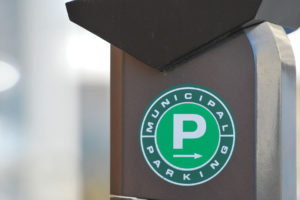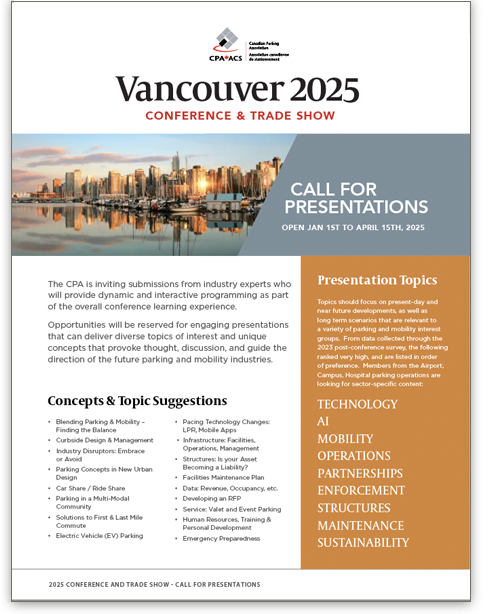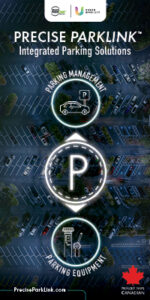By Renee Smith
The Canadian Parking Association and its membership have always been supportive of students and young parking professionals trying to make their way into the industry. To remain strong, we must continue to support bright and inventive ideas by fostering the success and growth of emerging individuals—not just for those who want to join our industry. For those who want to redefine it.
Over the years, our industry has managed to keep up with the growing needs of our users. Our developments have had an extraordinary impact on the lives of Canadians and the communities where we live. New parking-planning approaches are improving the quality of life in our cities and promoting business development by giving us safer and more user-friendly parking facilities. Nowhere has the transformation of our industry been more apparent than in the growth of parking’s technology sector.
Today we take for granted technologies that yesterday seemed unimaginable. It wasn’t so long ago, for example, that most parkade transactions were made in cash and collected by cashiers at exit kiosks. Cars often piled up in exiting queues and theft was a nagging concern for parkade owners. Now, with tap payments becoming ubiquitous, most facilities have automated systems that can process credit cards. Exiting queues are not yet a thing of the past, but they are less frequent and shorter when they do occur.
Of course, it’s not just payment equipment that’s changing the face of the industry. Who could have foreseen mobile payment apps and parking guidance technology just a generation ago? The demand for tech-savvy parking infrastructure will only increase as advances in Smart Cities and smart-vehicles evolve. Inevitably, technology will dominate the industry for coming generations. We need to make sure that when self-driving vehicles are ready, parking technology, from advanced access…
By Chelsea Webster
First and foremost – what the heck is gamification? Great question. It’s the process of taking something that already exists (an app, or a website, for example), and integrating game mechanics to it, so that you end up with an augmented version that people are more motivated to use1. It’s not building a new game – it’s making whatever you’re already doing into a game.
To better understand the concept, consider a few common elements that almost every gamified system has: points, levels, achievements, a leaderboard, and rewards2. No matter what app or online games you’ve played, consider how these elements add up to pique your curiosity.
Let me give you a quick example. I’ve used a customer relationship management tool that utilizes gamification (https://crm.me/gamification/). As a new user, I log in and have a grand total of 0 points. As I click on different tabs and features, the system awards me points. There’s a progress bar for how many tutorials I’ve watched, so I plug away at that because I can see exactly how far I’ve come and what’s left to be done. It’s satisfying to get that kind of feedback. I build up my understanding of the application’s functionality and learn to update customer information and make notes in profiles. After I do this a couple of times, I earn enough points to move from level 1 to level 2. With that level up, I’ve unlocked a new task and can send email to customers, earning me a badge! A badge! Yes! What a great reward!
And imagine if the rewards that you get keep getting more appealing. It starts off with some trinkets or badges, moves up to earning power, access to locked content, and finally culminates in an elevated status in the game3. I’m not even…
By Chris Hylton
Earlier this year we sent out a survey to members of the Canadian Parking Association. The survey asked a variety of questions about issues to identify the emerging trends and help the industry respond.
Regarding data, we asked about how organizations were using data, real-time and projected, to drive parking policy and design. We also asked about the relationship between data and funding expansion projects.
Regarding technology, we asked about how organizations were implementing new technology and the success rate. This included things like parking and payment apps as well as charging stations.
Regarding customer experience, we asked about how technology and online relationships via social media channels have helped to improve the overall customer experience.
Data Use Trends
93% of respondents reported that they were seeing an increased use of data to drive their service and design. Just a few of the data points that organizations are tracking include: number of vehicles, fees, payment methods, type of vehicle (i.e.: gas, hybrid, electric), turnover, event usage, parking via permit, versus daily, or hourly paid.
Digital Technology Continues to Drive the Industry
Common technological trends mentioned by survey participants included the emergence and adoption of parking apps, mobile payment options, and the provision of charging stations for electric vehicles.
Over time parking apps have simply exploded. A few years ago, Calgary’s ParkPlus system which permitted payment by phone, was revolutionary. Now apps cover every conceivable aspect of our industry. From the customer perspective there are apps involved in guidance, payment, all in one, and even handsfree no touch apps.
As automakers rush to meet customer demands to turn vehicles into four wheeled smart phones, parking apps are hitting vehicle screens with increasingly sophisticated parking support.
Ford Motor Co. has developed FordPass, a vehicle system that can, among others, find and pay for…
Torontonians wanted an app for parking — and they got it
By Stacy Sneed
One of the fastest growing cities in North America, Toronto is a hub for the design, finance, science and media industries. The city is also known for its tech savviness and app usage. In 2016, the latest report by Yahoo Canada! shared that Canadian app use grew by an average rate of 74 percent, far exceeding the global average of 11 percent. In fact, the number of Canadian devices exceeds the estimated number of Canadians by more than 2 million. What this signifies is that people in Toronto enjoy the ease and convenience apps add to their lives. When citizens become accustomed to the advantages that apps provide, they want to have access in every part of their lives … including interactions with their local government.
As this growing metropolitan area reached over 6 million residents in 2014, it faced increased congestion and traffic. Finding parking in Toronto became a hassle for drivers, and parking payment options were limited. Drivers either had to have cash available for meters or use their credit cards at a pay station. The Toronto Parking Authority (TPA) realized that point of frustration for drivers, and saw an opportunity to offer a better way to pay for parking. TPA issued a request for proposal (RFP) for mobile pay providers in 2014 in an effort to improve the overall parking experience around the city.
“The choice to go with a mobile app was heavily driven by our customers. We also wanted to provide an operational cost savings with it,” said Ian Maher, TPA’s vice president of strategic planning and I.T.
TPA sought a solution to implement technology and make local trips faster and easier. In order to achieve that, the…
By Renee Smith, JD MBA
Canada’s cities have long struggled with how to make their streets (and sidewalks and neighborhoods) more accessible to people with disabilities. There are many barriers to handicap access, including curbs bordering sidewalks, paucity of parking spaces designated solely for use by people with disabilities, and inaccessible buses and other forms of public transportation for people who don’t want to drive into the heart of the city. Add to that snow drifts, which are a common presence on our streets and sidewalks, and it’s easy to understand why it can be so difficult for people with disabilities to often struggle in our cities.
One area where cities sometimes fall short when it comes to accessibility is parking. That’s because it’s easy to fall into the trap of only addressing the most obvious accessibility issues, such as the size and location of parking spaces for people with disabilities. These are obviously important issues, but they only address part of the issue.
For many cities accessibility often ends at the curb cut. Parking planners tend to do a good job of making it easy to find appropriate parking and get safely out of vehicles and onto sidewalks. However, they don’t always give as much thought to their parking equipment, particularly meters and parking payment machines.
Impossible To Use
Not all parking equipment is designed with the needs of people with disabilities in mind, and older equipment can be particularly problematic. It’s often too tall or poorly designed for them to use, particularly those in wheelchairs. With the advent of pay-on-foot systems and smart meters, payment kiosks have become a common sight in cities. Unfortunately drivers with disabilities, particularly those in wheelchairs, sometimes can’t use these meters and kiosks because the credit card slots and cash receptacles in the equipment…
By Danielle Desjardins
One of the greatest environmental challenges our cities face today lies in mobility. The economic and social fabric of urban environments are closely intertwined with networks of vehicles and transportation systems that leave their mark: around one-quarter of global CO2 emissions come from the transportation of people and goods.
How should the parking industry adapt to a future in which major cities may deploy various strategies meant to diminish the number of private vehicles on their main thoroughfares, thus diminishing the need for parking spaces?
If you commuted to work by car in Montreal or Toronto in 2017, chances are you spent the equivalent of a normal work week being stuck in traffic. According to the Inrix Traffic Scorecard Rank1, commuters from these cities wasted respectively 50 and 47 hours being in a car immobilized by congestion.
As the population grows and more people move into urban areas, overwhelmingly choosing the suburbs over downtowns, traffic jams worsen and commuting to work becomes a never-ending nightmare. Hence a growing trend in major cities to implement various strategies and impose new rules to ease the gridlock and get people moving again.
For instance, many cities are banning cars from their centers: Oslo has pledged to do it by 2019, Madrid wants to do it in 2020, while cities like Rome, Dusseldorf and Stuttgart are planning to ban diesel cars in the near future.2 Other cities, like London, plan to create streets and street networks that encourage walking, cycling and public transport use in order to reduce car dependency3. Add this to other recent developments, like the proliferation of ride-sharing and car-sharing services and the advent of driverless cars getting people to work and returning home to park4, and you have the perfect storm for a decline in demand for parking garage services.
Embarking…
By Jessica Bates
A decade from now, many of us could be commuting to work in cars that drive themselves. For some, this sounds like science fiction; others can’t imagine willingly handing over the wheel to a computer. Nonetheless, driverless cars are almost certainly coming to a road near you, and they are likely to transform how we work and live in more ways than we can predict.
Driverless cars—also called autonomous cars or self-driving cars—are unmanned vehicles capable of sensing their environments and navigating without any human input. Early versions of these cars already exist and they are becoming more reliable and sophisticated every day. Commercial building owners and managers need to start thinking about how the autonomous vehicle revolution will affect their properties—from the loss of parking revenue to new development opportunities to the potential increase in tenant amenities.
THE TIPPING POINT
Cities already are starting to see significant shifts in commuter behavior with the rise of ride-sharing services, such as Uber and Lyft. More and more young people are entering the workforce without owning a car—or even having a driver’s license. J.F. Finn, III, AIA, principal and studio director for architecture and design firm Gensler, believes these behaviors will accelerate the rise in self-driving vehicles. “My nephews and nieces have no interest in car ownership—it doesn’t represent freedom and autonomy the way it has to previous generations,” Finn explains. “Many people are getting around just fine these days without the costs and inconveniences of owning their own car.”
Gensler’s research team predicts that, by 2021, ride-sharing services will become the dominant form of transportation, at least in urban centers. He calls this the “tipping point” where large numbers of autonomous vehicles become realistic. While today’s autonomous cars still require some human oversight, there is widespread optimism that fully autonomous cars will…
I am looking for any standards or suggestions on installation of charging stations in public parking facilities. In particular is there a suggested number or has anyone seen a suggested formula in determining how many should be included in any new developments? – Fred Crittenden












